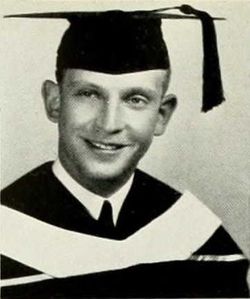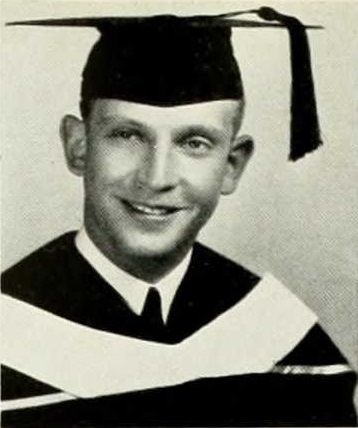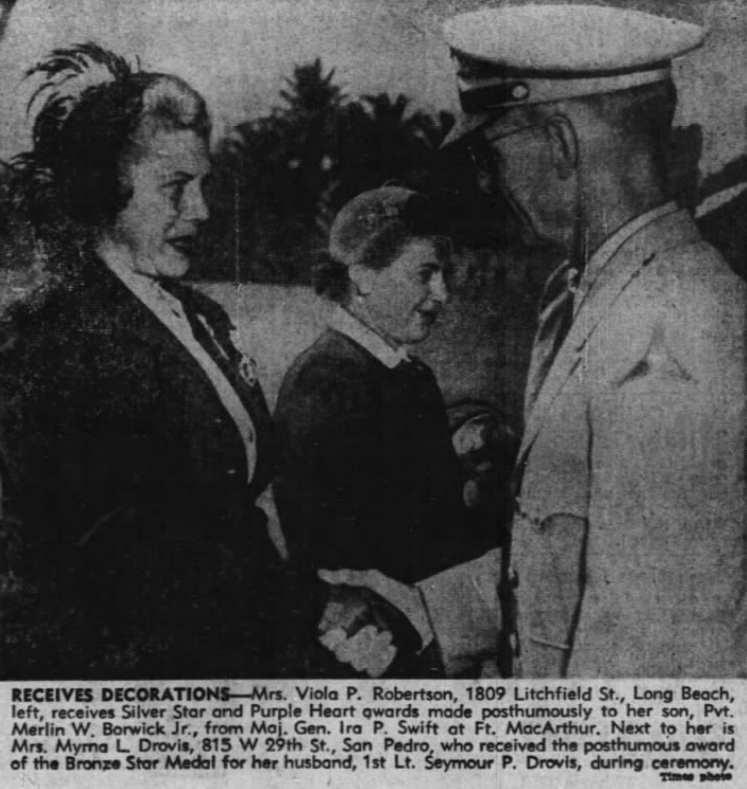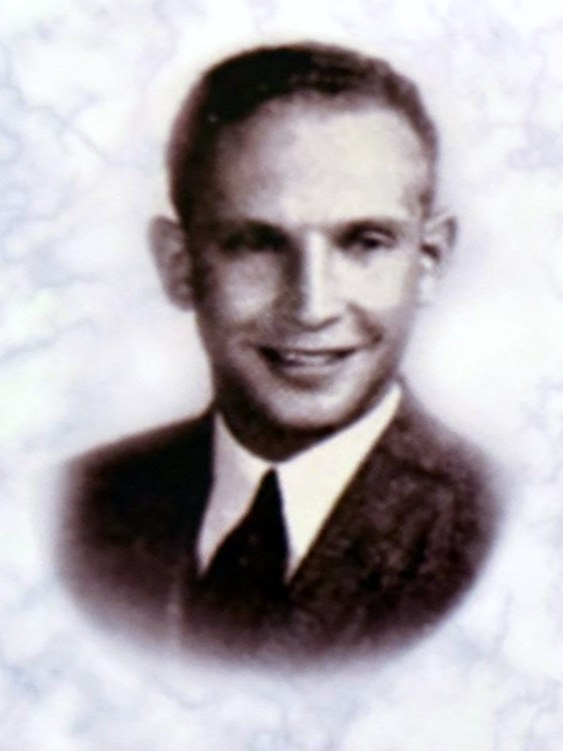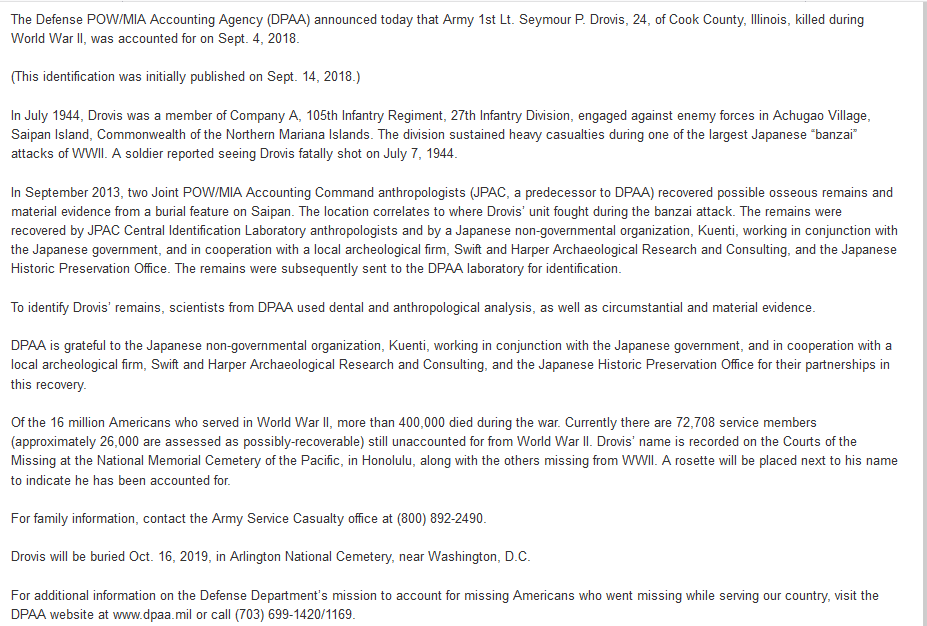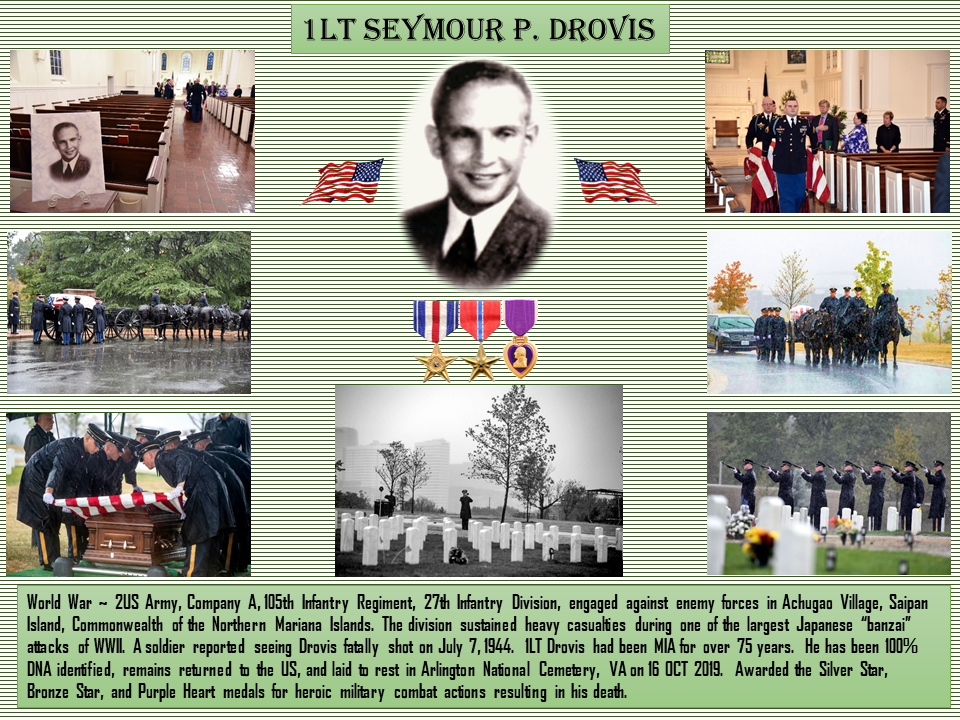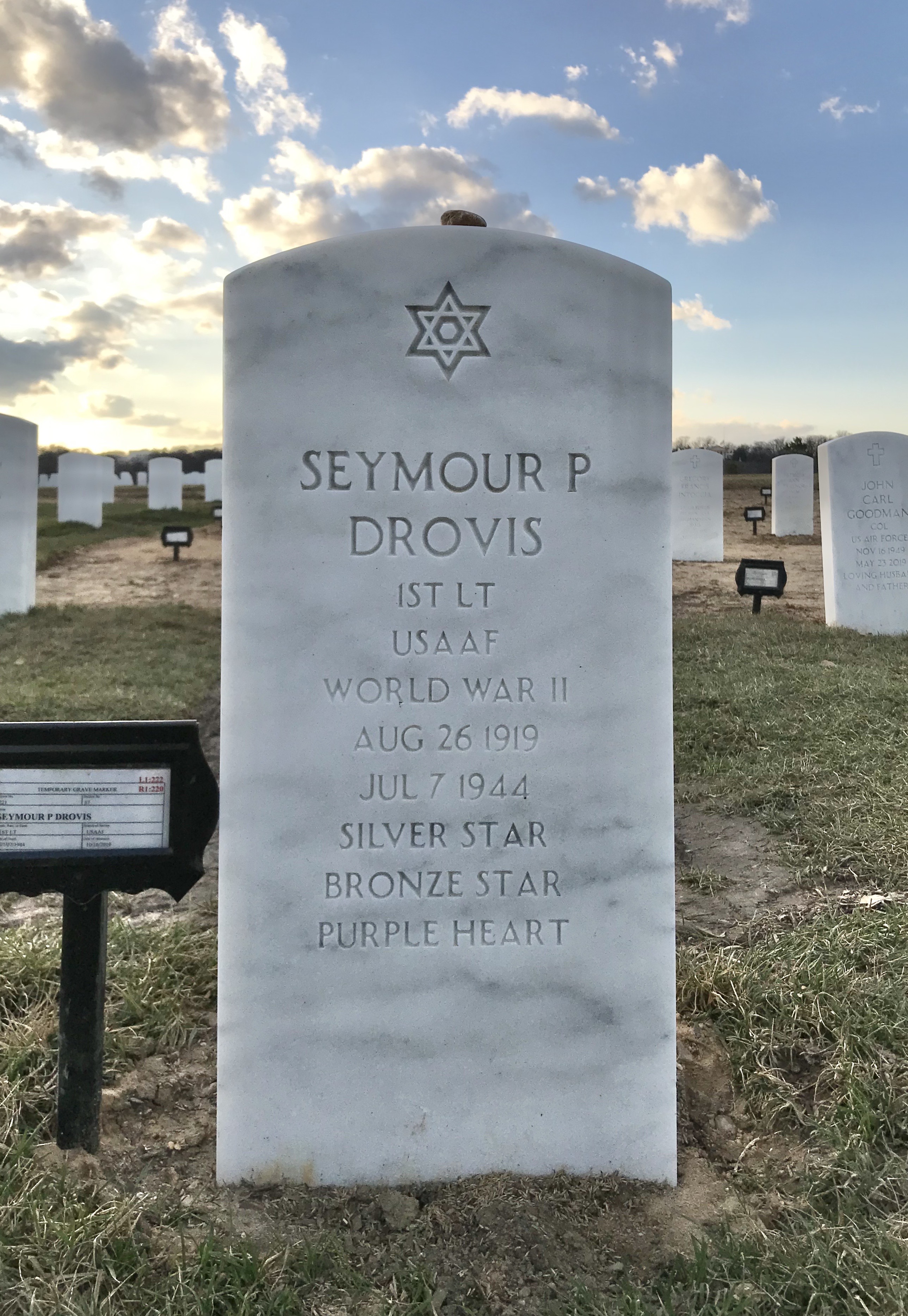Born in Chicago, Seymour was the only child blessed to the union of Isidor and Esther (nee Kahn) Drovis. Soon after the family moved to the Los Angeles to begin their new chapter.
Seymour met his future bride at Los Angeles High School. Myrna went on to Los Angeles Junior College and Seymour to UCLA.
A 1940 graduate of UCLA with a Bachelor of Science in Marketing, Seymour made California Men, Circle C (UCLA's minor sports honorary) for lettering as a light heavyweight Bruin and Alpha Delta Sigma (UCLA's national professional advertising fraternity). The 5' 9", 167 lbs, fair skinned, grey eyed, blonde was still living in Los Angeles, but working at Bullocks Incorporated when he registered for the draft the following October.
Seymour Drovis was a platoon leader with Company A, 105th Infantry Regiment, 27th Infantry Division when they departed for Hawaii March 10th 1942 and arrived on March 17th 1942. The Regiment's 3rd Battalion landed on Butaritari Island, the principal island of the Makin Atoll on November 20th 1943. It formed a Special Landings Group, which preceded the main landing craft in amtracs (Amphibious Tanks) and cleared the beaches for the subsequent landing waves coming through King's Wharf. The Battalion fought with the 165th Infantry for the remainder of the battle and on November 24, 1943 left the atoll for Hawaii, where they arrived on December 2nd 1943. For his actions on November 20th, Seymour earned the Silver Star.
During his R&R, Seymour and Myrna (stationed in Hawaii as a nurse) were married.
The Regiment left Hawaii on May 31st and landed on Saipan on the 17th of June 1944, where it fought with the rest of the 27th Division for the first time. The 105th Regiment was initially responsible for clearing the hilly and well fortified southern point of Saipan, which was later found to have been held by over 1,200 Japanese defenders. Following this, the Regiment joined the rest of the 27th Division and the 2nd and 4th Marine Divisions for what would be an extremely bloody assault on Mount Tapotchau, the island's key defensive position. Near the end of the battle, the 105th also bore the brunt of the largest Banzai charge of the entire war, its 1st and 2nd Battalions killing by actual count 2,295 Japanese. For his actions on July 7th, Seymour earned the Bronze Star.
A soldier reported seeing Drovis fatally shot, but the Los Angeles Times reported to his family, friends, neighbors and classmates that Seymour was Missing In Action.
Seymour's family would posthumously accept his Silver Star, Bronze Star with Oak Leaf Cluster and Purple Heart.
In September 2013, two Joint POW/MIA Accounting Command anthropologists (JPAC, a predecessor to DPAA) recovered possible osseous remains and material evidence from a burial feature on Saipan. The location correlates to where Drovis' unit fought during the banzai attack. The remains were recovered by JPAC Central Identification Laboratory anthropologists and by a Japanese non-governmental organization, Kuenti, working in conjunction with the Japanese government, and in cooperation with a local archeological firm, Swift and Harper Archaeological Research and Consulting, and the Japanese Historic Preservation Office. The remains were subsequently sent to the DPAA laboratory for identification.
To identify Drovis' remains, scientists from DPAA used dental and anthropological analysis, as well as circumstantial and material evidence.
DPAA is grateful to the Japanese non-governmental organization, Kuenti, working in conjunction with the Japanese government, and in cooperation with a local archeological firm, Swift and Harper Archaeological Research and Consulting, and the Japanese Historic Preservation Office for their partnerships in this recovery.
Drovis' name is permanently inscribed in Court 7 of the Courts of the Missing at the National Memorial Cemetery of the Pacific's Honolulu Memorial in Hawaii, along with the others missing from WWII. A rosette will be placed next to his name to indicate Seymour has been accounted for (56129119, cenotaph).
SOURCE:
Jennifer Morrison, forensic genealogist
DPAA Release No: 19-096 (June 7, 2019)
COMMENDATION: SILVER STAR
Lt Drovis and his infantry platoon, a part of the assault wave, had the initial mission of reducing all enemy resistance on or around a wharf which jeopardized the flank of the beachhead on ***, in the Central Pacific theater, on Nov 20, 1943. He landed at the end of the wharf in an LCVT, under heavy enemy machine gun finre from the wharf and also from the shore. Completely ignoring his personal safety, he led his men, by swimming and wading in the water along the wharf, under the enemy fire from the shore, until all enemy resistance on the flank had been reduced. During the second day, his platoon was designated as part of the assault unit, which was reinforced by medium tanks. Because of inadequate communication, it was necessary for him to expose himself repeatedly during the attack by preceeding the tank attached to his platoon in order to place its fire on the hostial resistance his platoon encountered. Lt Drovis continually in front of his men, displayed exceptional courage and resourcefulness throughout the operation.
Born in Chicago, Seymour was the only child blessed to the union of Isidor and Esther (nee Kahn) Drovis. Soon after the family moved to the Los Angeles to begin their new chapter.
Seymour met his future bride at Los Angeles High School. Myrna went on to Los Angeles Junior College and Seymour to UCLA.
A 1940 graduate of UCLA with a Bachelor of Science in Marketing, Seymour made California Men, Circle C (UCLA's minor sports honorary) for lettering as a light heavyweight Bruin and Alpha Delta Sigma (UCLA's national professional advertising fraternity). The 5' 9", 167 lbs, fair skinned, grey eyed, blonde was still living in Los Angeles, but working at Bullocks Incorporated when he registered for the draft the following October.
Seymour Drovis was a platoon leader with Company A, 105th Infantry Regiment, 27th Infantry Division when they departed for Hawaii March 10th 1942 and arrived on March 17th 1942. The Regiment's 3rd Battalion landed on Butaritari Island, the principal island of the Makin Atoll on November 20th 1943. It formed a Special Landings Group, which preceded the main landing craft in amtracs (Amphibious Tanks) and cleared the beaches for the subsequent landing waves coming through King's Wharf. The Battalion fought with the 165th Infantry for the remainder of the battle and on November 24, 1943 left the atoll for Hawaii, where they arrived on December 2nd 1943. For his actions on November 20th, Seymour earned the Silver Star.
During his R&R, Seymour and Myrna (stationed in Hawaii as a nurse) were married.
The Regiment left Hawaii on May 31st and landed on Saipan on the 17th of June 1944, where it fought with the rest of the 27th Division for the first time. The 105th Regiment was initially responsible for clearing the hilly and well fortified southern point of Saipan, which was later found to have been held by over 1,200 Japanese defenders. Following this, the Regiment joined the rest of the 27th Division and the 2nd and 4th Marine Divisions for what would be an extremely bloody assault on Mount Tapotchau, the island's key defensive position. Near the end of the battle, the 105th also bore the brunt of the largest Banzai charge of the entire war, its 1st and 2nd Battalions killing by actual count 2,295 Japanese. For his actions on July 7th, Seymour earned the Bronze Star.
A soldier reported seeing Drovis fatally shot, but the Los Angeles Times reported to his family, friends, neighbors and classmates that Seymour was Missing In Action.
Seymour's family would posthumously accept his Silver Star, Bronze Star with Oak Leaf Cluster and Purple Heart.
In September 2013, two Joint POW/MIA Accounting Command anthropologists (JPAC, a predecessor to DPAA) recovered possible osseous remains and material evidence from a burial feature on Saipan. The location correlates to where Drovis' unit fought during the banzai attack. The remains were recovered by JPAC Central Identification Laboratory anthropologists and by a Japanese non-governmental organization, Kuenti, working in conjunction with the Japanese government, and in cooperation with a local archeological firm, Swift and Harper Archaeological Research and Consulting, and the Japanese Historic Preservation Office. The remains were subsequently sent to the DPAA laboratory for identification.
To identify Drovis' remains, scientists from DPAA used dental and anthropological analysis, as well as circumstantial and material evidence.
DPAA is grateful to the Japanese non-governmental organization, Kuenti, working in conjunction with the Japanese government, and in cooperation with a local archeological firm, Swift and Harper Archaeological Research and Consulting, and the Japanese Historic Preservation Office for their partnerships in this recovery.
Drovis' name is permanently inscribed in Court 7 of the Courts of the Missing at the National Memorial Cemetery of the Pacific's Honolulu Memorial in Hawaii, along with the others missing from WWII. A rosette will be placed next to his name to indicate Seymour has been accounted for (56129119, cenotaph).
SOURCE:
Jennifer Morrison, forensic genealogist
DPAA Release No: 19-096 (June 7, 2019)
COMMENDATION: SILVER STAR
Lt Drovis and his infantry platoon, a part of the assault wave, had the initial mission of reducing all enemy resistance on or around a wharf which jeopardized the flank of the beachhead on ***, in the Central Pacific theater, on Nov 20, 1943. He landed at the end of the wharf in an LCVT, under heavy enemy machine gun finre from the wharf and also from the shore. Completely ignoring his personal safety, he led his men, by swimming and wading in the water along the wharf, under the enemy fire from the shore, until all enemy resistance on the flank had been reduced. During the second day, his platoon was designated as part of the assault unit, which was reinforced by medium tanks. Because of inadequate communication, it was necessary for him to expose himself repeatedly during the attack by preceeding the tank attached to his platoon in order to place its fire on the hostial resistance his platoon encountered. Lt Drovis continually in front of his men, displayed exceptional courage and resourcefulness throughout the operation.
Family Members
Sponsored by Ancestry
Advertisement
Records on Ancestry
Advertisement
